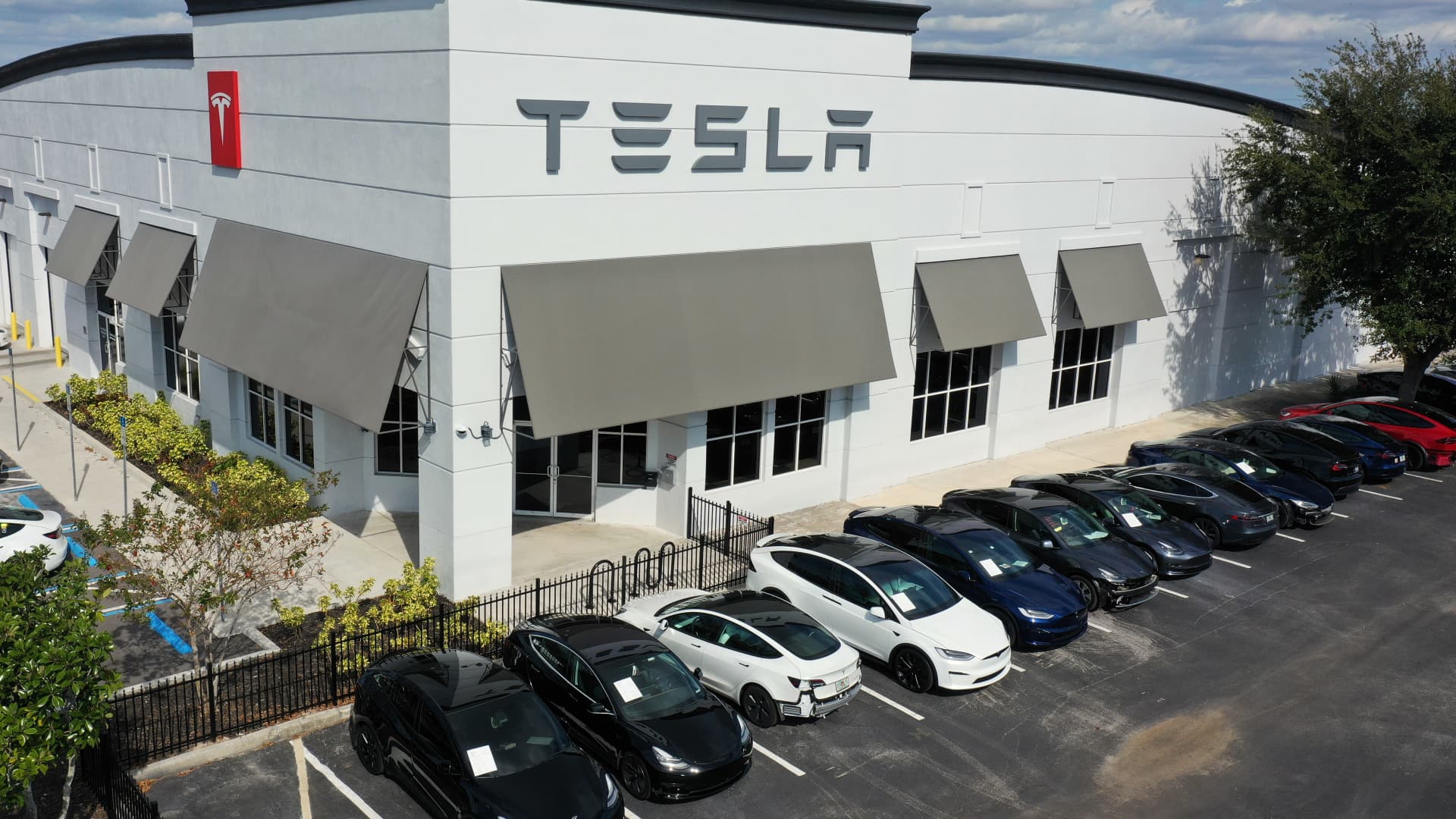When Tesla slashed the prices of some of its electric vehicles at the start of the year, it jolted the auto industry and kicked off the start of a price war — weeks later, Ford lowered the price of its Mach-E. The event may have created a compelling entry point for investors who have been on the sidelines of the long-term shift to electric vehicles. “It’s really become a stock picker’s market,” said Garrett Nelson, an equity analyst at CFRA. Electric vehicles are becoming much more popular in the U.S. but still make up a small portion of automobiles on the roads. In 2022, EVs made up about 5% of total vehicles sold in the U.S., according to data from Edmunds. That’s nearly double sales from just a year prior, showing the quick growth in the segment. “It is expected to grow quite significantly,” said Jessica Caldwell, Edmunds’ executive director of insights. She added that this means a lot of new products are hitting the streets. The increased competition is already having an impact. Tesla is still the winner in new EV sales, but its lead is shrinking. In 2022, Tesla’s made up about 59% of new EV sales, down from 66% in the previous year. Brands Hyundai/Kia, Ford and Rivian all grew market share last year. “We believe electrification to be an inevitability,” said Brian Sponheimer, a portfolio manager at Gabelli Funds. A bid to reclaim market share Tesla’s price cuts may be part of a strategy to grab back market share in the U.S. and abroad. The automaker lowered the cost of all new vehicles in the U.S. by as much as 20% and cut prices on some models in Europe as well. The moves follow similar price cuts in China meant to entice buyers. Also, the lower prices in the U.S. potentially help the cars qualify for federal EV tax credits available through the Inflation Reduction Act, a further incentive for potential consumers. Some analysts cheered the move. Berenberg upgraded shares of the automaker to buy , saying the cuts are part of a larger strategy even if they hit profits. Dan Ives of Wedbush said in a Jan. 19 note that price cuts in China are already a “huge success.” Of course, the lower prices will eat into profits, which will be a problem if volume doesn’t pick up sufficiently. Per vehicle, revenue may fall 10% to 20%, according to a Jan. 17 note from John Murphy at Bank of America. At the same time, however, he predicted Tesla’s volume will rise 53% in 2023. Cutting prices certainly caught the eye of consumers and boosted interest in Tesla vehicles, according to data from Edmunds. On-site shopper consideration of Teslas jumped to 4% from 1.9% in a week, and the Tesla Model Y became the second-most researched vehicle on the site, up from the 70th a week before. RBC Capital Markets cited strong consumer response to Tesla’s price cut for its decision to raise its price target Monday on Tesla to $233, or 17% upside from Friday’s close. A few weeks after Tesla’s price cuts, Ford responded by lowering the price of its Mustang Mach-E crossover , the vehicle that competes most with Tesla’s Model Y. Because of the cut, not all Mach-E models will be profitable on a per-unit basis. Still, Ford is nearly doubling production from 78,000 vehicles to 130,000 annually to stay competitive. General Motors , however, has so far decided to hold its own prices steady. “When we look at our strong product portfolio and the interest that we have at the prices that we’ve already announced, we feel that we’re well positioned,” CEO Mary Barra said Tuesday on a call with analysts when asked about price cuts at Tesla and Ford. “Even going into the first month of the year, we’ve seen a very strong customer interest in our products.” It remains to be seen exactly how the price cuts will affect sales in 2023, but it’s expected to be an issue for automakers. “It is a dramatic headwind in the first half of the year,” said Gene Munster, managing partner at Deepwater Asset Management. “I think it’s going to be measurable.” Competition shakeout Some analysts see increased competition eating away at Tesla’s market share. Others see its first-mover advantage and popular brand as the keys to future growth. With dozens of new vehicles coming to the market in the next few years, it could reach a point of oversaturation that will overwhelm consumers, according to Nelson. “You’re going to see a lot of traditional automakers and newer EV manufacturers such as Lucid , Rivian, Fisker and others really struggle in the coming quarters,” he said. He has a buy rating on shares of Tesla, a buy on Ford and a sell on GM. There’s also the question of manufacturing and reach. While traditional original equipment manufacturers, or OEMs, have large established factory networks and capital to put behind new development, Tesla has been focused on only electric vehicles and has built its factories solely for that purpose. “Tesla does have an advantage when it comes to the fact that they’ve been building from the ground up,” said Munster, adding that he thinks it allows them to build cars cheaper than competitors, an advantage for customers. However, Tesla may be falling behind in some areas. For one, its vehicle lineup is getting old, according to Caldwell. While consumers are waiting on the Cybertruck, there aren’t other new models on the horizon. And, there are still issues with electric vehicles that make them impractical for large groups of consumers, said Mike Ward, an analyst at The Benchmark Company. He has buy ratings on GM and Ford. For instance, if you live in Vermont and want to go skiing, it’s not very practical, he said. “There aren’t enough charging stations, you don’t get the range, as you lose a lot of range at high altitude, high speed and in cold weather or volatile weather,” Ward said. In addition, Tesla isn’t as well suited to capitalize on growth on electric vehicles in the commercial sector, such as fleets of commercial pickup trucks and vans. General Motors and Ford control most of that market in the U.S. and Ford currently has the best electric pickup truck, according to Ward. “Your plumber that has a pickup truck is not going to buy the Cybertruck for $100,000,” said Ward. It’s also important to remember that incumbent automakers still have the monopoly on traditional vehicles and offer other forward-looking technologies such as hybrid cars or ones that run on diesel fuel or hydrogen. “[Traditional auto companies] have a diverse lineup and diversity is important for a variety of reasons,” Sponheimer said. More cars for sale means you’ll likely reach more consumers with a broader array of needs. “Those other more traditionally powered vehicles, which are going to be with us for decades to come, can help to minimize the ups and downs that might come with the electrification program.” The breakdown for investors What investors must decide for themselves is which automakers will ultimately produce the most value for consumers and continue to hold market share, said Munster. For some, that means sticking with Tesla even with its ups and downs. It’s generally well-liked — issues with CEO Elon Musk aside — and one of the most-liked auto companies on Wall Street. Roughly two-thirds of analysts who cover Tesla say to buy the stock. Bulls also still see incredible upside — Adam Jonas of Morgan Stanley has a $220 price target on shares, implying the price could rise nearly 16% from Friday’s close. TSLA YTD line tsla chart ytd Others may want to take a more traditional approach. “I think it’s perfectly feasible for someone to say, ‘I’m going to own Ford even though they aren’t there today because I think they’re going to have the best value and the best option,’” said Munster. General Motors also offers a solid traditional option, and investors looking for companies with lots of growth outside the U.S. should also consider Toyota , Hyundai , Kia or Mazda. The traditional companies are also more likely to pay a dividend, an important consideration in today’s choppy market. Both Ford and General Motors pay dividends — GM’s is nearly 1%, and Ford’s is 4.4%. GM YTD line GM ytd That’s important because even if the stock price does nothing, investors will still see that payment return. “We really like companies that pay dividends, have generated strong balance sheets, generate strong cash flow and can continue to return cash to shareholders,” Nelson said, adding that Ford could also potentially announce share buybacks soon, another benefit to investors. F YTD line Ford ytd Thinking beyond the car There is also a myriad of ways to invest in the trend while protecting oneself from the risk of buying shares of a startup that could go under from one dud vehicle, according to Sponheimer. “Where we are really focused as a firm is on reducing that product risk and choosing the technologies that we think are going to be important for all automakers,” he said. That includes investing in companies that make things such as axles and drivelines for trucks and SUVs, such as Dana , an auto supplier. The firm also likes BorgWarner , another supplier, and Garrett Motion , a smaller manufacturing company that makes turbochargers. And it named ChargePoint , a maker of EV charging stations, one of its best ideas for 2023. “We are a little bit less focused from a firm perspective on trying to figure out the actual products that win and more focused on the entirety of the ecosystem,” he said. There’s also a huge potential in firms that make batteries, key parts of electric vehicles that are also seeing surging share prices. Goldman Sachs has buy ratings on a number of battery makers they see benefiting from EV growth, including Freyr Battery , Sunrun and Enphase . Another way to get the upside of upstarts such as Tesla while potentially balancing it with consistency is by investing in an electric vehicle-focused exchange-traded fund. The Global X Lithium & Battery Tech ETF , which includes Tesla and Rivian, is up nearly 18% year to date. A broader fund, the iShares Self-Driving EV and Tech ETF, is up more than 22% this year. It includes Toyota, General Motors and Ford as well as Apple and Alphabet . The KraneShares Electric Vehicles and Future Mobility Index ETF also boasts a nearly 18% gain this year and includes Tesla, lithium producer Albemarle , auto tech supplier Aptiv and more. — CNBC’s Michael Bloom contributed reporting.








